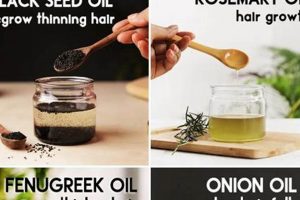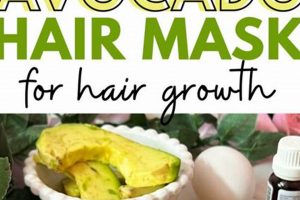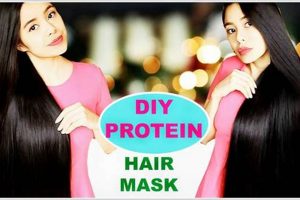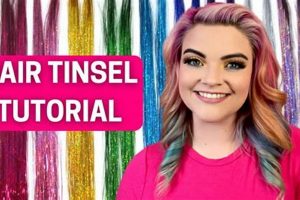The practice of creating homemade treatments to hydrate and condition hair involves utilizing readily available ingredients to formulate customized preparations. An example includes blending avocado, honey, and olive oil to create a nourishing concoction applied to the hair shaft. The appeal lies in its cost-effectiveness and control over ingredient selection.
Implementing this method offers several advantages. It allows individuals to avoid potentially harmful chemicals found in commercial products, tailor formulations to specific hair needs (e.g., dry, damaged, or color-treated), and often results in significant cost savings. Historically, utilizing natural elements for hair care predates mass-produced cosmetics, with evidence of ancient civilizations employing plant-based oils and extracts for similar purposes.
The subsequent sections will explore various aspects of this practice, including ingredient selection, formulation techniques, application methods, and potential benefits for different hair types. This will provide a comprehensive understanding of how to effectively incorporate this approach into a regular hair care routine.
Tips for Effective Homemade Hydrating Hair Treatments
Achieving optimal results with homemade hair treatments requires careful consideration of ingredient selection, application techniques, and adherence to recommended guidelines. The following tips will enhance the effectiveness of this process.
Tip 1: Ingredient Quality Matters: Utilize fresh, high-quality ingredients to maximize the nutritional benefits for the hair. For example, opt for organic, cold-pressed oils and ripe avocados.
Tip 2: Understand Hair Porosity: Hair porosity, the hair’s ability to absorb moisture, influences ingredient selection. High porosity hair may benefit from heavier oils like coconut or shea butter, while low porosity hair may prefer lighter oils such as argan or grapeseed oil.
Tip 3: Precise Formulation is Key: Follow established recipes and guidelines. Inaccurate proportions can lead to ineffective treatments or undesirable outcomes, such as oily residue.
Tip 4: Application Technique: Apply the treatment evenly from roots to ends, ensuring complete coverage. Sectioning the hair facilitates thorough application.
Tip 5: Controlled Application Time: Adhere to the recommended application time, typically 20-30 minutes. Over-exposure can lead to product build-up or potential scalp irritation.
Tip 6: Rinse Thoroughly: After the designated time, rinse hair thoroughly with lukewarm water to remove all traces of the treatment. Residual product can weigh down the hair.
Tip 7: Frequency Considerations: Adjust the frequency of treatments based on hair needs. Severely dry or damaged hair may benefit from weekly applications, while healthier hair may only require treatment every two to three weeks.
Implementing these tips enhances the likelihood of achieving significant improvements in hair hydration, softness, and overall health. Proper preparation and execution are crucial for realizing the full potential of this method.
The following sections will further delve into specific ingredient profiles and address common concerns associated with implementing homemade hydrating hair treatments.
1. Ingredient Selection
The foundation of effective homemade hair hydration treatments rests on informed ingredient selection. The chosen components directly determine the mask’s capacity to impart and retain moisture within the hair shaft. Ingredients serve distinct functions, such as providing emollients to smooth the hair cuticle, humectants to attract moisture from the environment, and occlusives to seal in hydration. For example, utilizing coconut oil (an emollient) can smooth the hair surface, but without the inclusion of honey (a humectant) to draw moisture in, the benefit may be limited. Similarly, shea butter (an occlusive) can trap existing moisture, but will not be as effective if the hair is initially dry.
Incorrect ingredient choices can negate the benefits or even cause adverse effects. Employing solely protein-rich ingredients without adequate moisturizing agents, for instance, may lead to hair stiffness and breakage. Individuals with sensitivities must also carefully vet ingredients to avoid allergic reactions or scalp irritation. A practical application involves conducting a patch test prior to full application, particularly when using essential oils or less common ingredients. Furthermore, the source and quality of ingredients influence the final outcome. Organic, unrefined oils generally possess a higher concentration of beneficial nutrients compared to their processed counterparts, contributing to improved hair health.
In summary, ingredient selection is not merely a preliminary step but an integral component of the entire hydrating treatment process. Careful consideration of individual hair needs, ingredient properties, and potential interactions are paramount. Addressing this aspect thoughtfully will maximize the treatment’s efficacy, promoting healthier, more hydrated hair. The key challenge lies in discerning the optimal combination of ingredients for a given hair type, underscoring the need for ongoing experimentation and refinement of personalized formulations.
2. Hydration Enhancement
Hydration enhancement constitutes a primary objective when formulating hair hydration treatments. The degree to which a mask can augment and sustain moisture levels within the hair fiber dictates its overall effectiveness. Treatments achieving superior hydration enhancement typically exhibit a noticeable improvement in hair elasticity, reduced frizz, and enhanced shine. The selection of humectants plays a crucial role, as these substances draw moisture from the environment and bind it to the hair shaft. For instance, the inclusion of aloe vera in a homemade treatment can effectively attract and retain moisture, leading to improved hydration. The absence of effective humectants diminishes the masks capacity to deliver significant hydration benefits, regardless of other beneficial ingredients present.
The practical significance of understanding hydration enhancement lies in the ability to tailor treatments to specific environmental conditions. In humid climates, employing humectants in moderation is advisable to prevent excessive moisture absorption, which can lead to limp hair. Conversely, in dry climates, a more concentrated approach with humectants is necessary to counteract the dehydrating effects of the environment. Additionally, the interplay between humectants and occlusives is critical. Occlusives, such as natural oils, serve to seal in the moisture attracted by humectants, prolonging the hydration effect. A treatment lacking effective occlusives may result in rapid moisture loss, negating the benefits of the humectants. Proper understanding facilitates customization, addressing particular challenges, and maximizing the hydrating efficacy.
In summary, hydration enhancement is a cornerstone of effective hair hydration masks. It relies on the strategic integration of humectants and occlusives, carefully adjusted to suit specific hair needs and environmental conditions. A comprehensive understanding of this principle is vital for achieving sustained hydration, thereby improving hair health and appearance. This focus mitigates formulation errors and promotes informed selection of specific ingredients to meet identified needs.
3. Scalp Health
The condition of the scalp directly influences the efficacy of any hair hydration regimen. A healthy scalp provides an optimal environment for hair growth and moisture retention, whereas an unhealthy scalp can impede these processes, regardless of the hydrating treatments employed.
- Sebum Production and Balance
Sebum, the natural oil produced by the scalp, plays a crucial role in maintaining moisture levels. Overproduction can lead to an oily scalp, while underproduction results in dryness and potential flakiness. Homemade hydrating treatments can either exacerbate or alleviate these conditions depending on the ingredients used. For instance, applying coconut oil to an already oily scalp can lead to clogged pores and hinder natural sebum regulation, whereas using aloe vera on a dry scalp can help restore balance.
- Inflammation and Irritation
Inflammation, caused by conditions such as eczema or psoriasis, can disrupt the scalps natural barrier function, leading to moisture loss and reduced hair health. Certain ingredients in homemade masks, such as harsh essential oils or preservatives, can further irritate the scalp, negating the benefits of hydration. Utilizing calming ingredients, such as chamomile or colloidal oatmeal, can help mitigate inflammation and support scalp health, thereby optimizing the effects of moisturizing treatments.
- Follicle Health and Circulation
Healthy hair follicles are essential for proper hair growth and nutrient absorption. Poor circulation and clogged follicles can impede these processes, resulting in dry, brittle hair. Scalp massage, often incorporated during the application of homemade masks, can stimulate circulation and promote follicle health, enhancing the overall effectiveness of the hydrating treatment. Ingredients such as peppermint oil, known for its stimulating properties, can further enhance circulation and nutrient delivery to the follicles.
- Microbiome Balance
The scalp hosts a complex ecosystem of microorganisms. An imbalance in this microbiome can contribute to various scalp issues, including dandruff and dryness. Certain ingredients, such as honey or yogurt, possess prebiotic properties that can help restore balance to the scalp microbiome. By promoting a healthy scalp environment, these ingredients enhance the effectiveness of hydrating treatments and contribute to long-term hair health.
Addressing scalp health through informed ingredient selection and application techniques is paramount for maximizing the benefits of homemade hydrating treatments. Ignoring the scalps condition can lead to ineffective or even detrimental results, underscoring the importance of a holistic approach to hair care. Therefore, treatments should not only focus on hydrating the hair shaft but also on nurturing and maintaining a healthy scalp environment, leading to sustainable improvements in hair health and appearance.
4. Application Technique
Effective implementation of homemade hair hydration treatments hinges not only on ingredient selection but also significantly on the application technique employed. Proper application ensures uniform distribution of the moisturizing compounds, maximizing their contact time with the hair shaft and scalp, thereby amplifying their beneficial effects.
- Sectioning and Preparation
Dividing the hair into manageable sections facilitates thorough and even application of the mask. This process ensures that every strand receives adequate coverage, preventing areas from being overlooked. Prior to application, detangling the hair minimizes breakage and allows for smoother distribution of the treatment, increasing its efficacy.
- Root-to-Tip Distribution
While the emphasis is on hydrating the hair shaft, addressing the scalp is equally important. Applying the mask from root to tip ensures that the scalp receives the benefit of nourishing ingredients, promoting overall hair health. Gentle massage during application stimulates blood circulation, further enhancing nutrient absorption and promoting healthy hair growth.
- Incubation and Heat Application
Allowing the mask to incubate for the recommended duration is crucial for optimal absorption of moisturizing compounds. Covering the hair with a warm towel or shower cap creates a humid environment, promoting deeper penetration of the treatment into the hair shaft. Gentle heat application, such as using a hooded dryer, can further enhance this process.
- Rinsing and Residue Removal
Thorough rinsing with lukewarm water is essential for removing all traces of the mask. Residual product can weigh down the hair, leaving it feeling greasy or dull. A final rinse with cool water can help seal the hair cuticle, locking in moisture and enhancing shine. Proper rinsing ensures that the hair retains the benefits of the treatment without unwanted residue.
Therefore, achieving optimal results with homemade hydrating hair masks requires a conscientious approach to application technique. Paying attention to sectioning, distribution, incubation, and rinsing ensures that the treatment is effectively delivered, maximizing its hydrating and nourishing properties for improved hair health and appearance.
5. Hair Type Specificity
The effectiveness of homemade hair hydration treatments is intrinsically linked to the alignment of formulations with individual hair characteristics. Recognizing variations in hair texture, porosity, and overall condition is paramount when creating customized moisturizing masks.
- Fine Hair Considerations
Fine hair, characterized by its small diameter, is easily weighed down by heavy oils and butters. Utilizing lightweight ingredients such as aloe vera juice, honey, and diluted apple cider vinegar provides hydration without compromising volume or causing limpness. Overuse of rich emollients can result in a greasy appearance and reduced manageability.
- Coarse Hair Needs
Coarse hair, possessing a larger diameter, often requires more intensive hydration. Richer ingredients such as shea butter, coconut oil, and avocado oil can effectively penetrate the hair shaft, providing sustained moisture and reducing frizz. Regular application of these heavier emollients helps to maintain the hair’s elasticity and prevent breakage.
- Curly Hair Formulations
Curly hair is inherently prone to dryness due to the difficulty of natural oils traversing the coiled structure. Formulations containing humectants like glycerin and honey, combined with sealing oils like jojoba and grapeseed, help to attract and retain moisture within the hair shaft. Deep conditioning treatments are particularly beneficial for replenishing moisture and enhancing curl definition.
- Chemically Treated Hair Requirements
Chemical processes such as coloring, perming, and relaxing can compromise the hair’s natural moisture barrier, leading to increased dryness and damage. Hydrating masks formulated with reparative ingredients like hydrolyzed proteins, amino acids, and ceramides can help to strengthen the hair shaft and restore moisture balance. Regular deep conditioning treatments are essential for maintaining the health and integrity of chemically treated hair.
Therefore, tailoring homemade moisturizing hair masks to specific hair types is crucial for achieving optimal results. A generalized approach can lead to ineffective or even detrimental outcomes. Customized formulations that address the unique needs of each hair type are essential for promoting healthy, hydrated, and manageable hair.
6. Ingredient Synergy
Ingredient synergy, the combined effect of multiple components yielding a result greater than the sum of their individual effects, is a critical consideration in the formulation of effective homemade moisturizing hair masks. The strategic pairing of ingredients optimizes hydration, enhances nutrient delivery, and mitigates potential adverse effects, ultimately leading to improved hair health.
- Humectant and Emollient Pairing
Humectants attract moisture from the environment, while emollients smooth the hair cuticle and lock in hydration. Combining these ingredient types is essential for sustained moisturization. For example, pairing honey (a humectant) with coconut oil (an emollient) allows the hair to absorb and retain moisture more effectively than either ingredient used alone. The honey draws moisture into the hair shaft, and the coconut oil creates a protective barrier, preventing moisture loss. This synergy maximizes the hydrating benefits of the mask.
- Protein and Moisture Balance
Protein-rich ingredients can strengthen and repair damaged hair, but overuse can lead to stiffness and breakage. Balancing protein with moisturizing agents is crucial for maintaining hair elasticity and preventing adverse effects. Incorporating hydrolyzed proteins alongside humectants and emollients helps to rebuild the hair structure while ensuring adequate hydration. This balanced approach prevents protein overload and promotes overall hair health.
- Scalp Health and Hydration
A healthy scalp is essential for optimal hair growth and moisture retention. Ingredients that promote scalp health can enhance the effectiveness of hydrating treatments. For instance, incorporating aloe vera, known for its soothing and anti-inflammatory properties, alongside moisturizing ingredients can create a healthier scalp environment, improving nutrient absorption and moisture retention. This synergy addresses both hair and scalp health, leading to comprehensive benefits.
- pH Level Optimization
Maintaining the correct pH level is vital for hair health and moisture retention. Ingredients with acidic properties, such as apple cider vinegar, can help to close the hair cuticle, sealing in moisture and enhancing shine. Combining these ingredients with moisturizing agents creates a synergistic effect, promoting optimal hydration and overall hair health. This approach ensures that the hair is properly hydrated and protected from damage.
The principles of ingredient synergy underscore the importance of careful formulation in homemade moisturizing hair masks. The strategic combination of ingredients, considering their individual properties and potential interactions, is crucial for maximizing hydration, promoting hair health, and achieving optimal results. An understanding of these synergistic relationships empowers individuals to create customized masks that effectively address their specific hair needs, leading to healthier, more manageable hair.
Frequently Asked Questions
This section addresses common inquiries regarding the formulation and application of homemade hydrating hair treatments. The information presented aims to clarify best practices and potential challenges associated with this approach.
Question 1: Can homemade hair masks effectively replace commercial conditioners?
Homemade hair masks can serve as effective alternatives to commercial conditioners, provided that formulations are carefully selected to address specific hair needs. The efficacy depends on the quality of ingredients and the adherence to proper application techniques.
Question 2: How often should moisturizing hair masks be applied?
The frequency of application varies based on hair type and condition. Severely dry or damaged hair may benefit from weekly treatments, while normal hair may only require monthly application. Observation of hair response is crucial for determining the optimal frequency.
Question 3: What are the potential risks associated with DIY hair masks?
Potential risks include allergic reactions to ingredients, scalp irritation, and imbalances in hair protein levels. Prior testing of small areas is advised to mitigate allergic reactions. Using excessive protein is not recommended.
Question 4: Can essential oils be safely incorporated into hair masks?
Essential oils can be added for fragrance and therapeutic benefits, but caution is warranted. Dilution with a carrier oil is mandatory to prevent scalp irritation. Certain oils are contraindicated for pregnant or breastfeeding individuals.
Question 5: How can one prevent homemade hair masks from leaving residue?
Residue can be minimized by thoroughly rinsing hair after treatment and using appropriate quantities of oils. Diluting heavier oils, such as coconut oil, and avoiding excessive application can prevent product build-up.
Question 6: Is it possible to store leftover homemade hair masks?
Storage is dependent on the ingredients. Masks containing fresh ingredients are best used immediately to prevent spoilage. Preservative-free formulations may be stored in the refrigerator for a limited duration, typically up to 48 hours.
In summary, homemade moisturizing hair masks can be a valuable addition to a hair care routine, but success depends on informed selection, careful preparation, and diligent application.
The subsequent section will provide guidelines on troubleshooting common issues encountered when using homemade hydrating hair treatments.
Moisturizing Hair Mask DIY
The foregoing examination of moisturizing hair mask diy elucidates its multifaceted nature. The process encompasses informed ingredient selection, an understanding of hair type specificity, and meticulous application techniques. Successfully integrating these elements yields a cost-effective and customizable approach to hair hydration. However, a lack of attention to these details can lead to suboptimal or even detrimental results.
Therefore, individuals seeking to incorporate moisturizing hair mask diy into their regimens must prioritize comprehensive research and careful experimentation. The long-term benefits, including improved hair health and reduced exposure to synthetic chemicals, necessitate a commitment to diligent practice. Consistent application of well-formulated masks, tailored to individual hair characteristics, offers the greatest potential for realizing sustainable improvements in hair hydration and overall condition.







